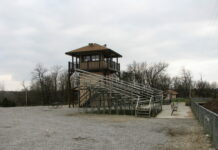Photo credit: DiasporaEngager (www.DiasporaEngager.com).
The San Francisco Police Department (SFPD) wants to get a robot quadruped, popularly known as a robot dog. The city’s Board of Supervisors has a regulatory duty to probe into this intended purchase, including potentially blocking it altogether.
The SFPD recently proposed the acquisition of a new robot dog in a report about the department’s existing military arsenal and its proposed future expansion. The particular model that SFPD claims they are exploring, Boston Dynamics’s Spot, is capable of intrusion and surveillance in a manner similar to drones and other unmanned vehicles and is able to hold “payloads” like cameras.
The SFPD’s disclosure came about as a result of a California law, A.B. 481, which requires police departments to make publicly available information about “military equipment,” including weapons and surveillance tools such as drones, firearms, tanks, and robots. Some of this equipment may come through the federal government’s military surplus program.
A.B. 481 also requires a law enforcement agency to seek approval from its local governing body when acquiring, using, or seeking funds for military equipment and submit a military equipment policy. That policy must be made publicly available and must be approved by the governing body of the jurisdiction on a yearly basis. As part of that approval process, the governing body must determine that the policy meets the following criteria:
- The military equipment is necessary because there is no reasonable alternative that can achieve the same objective of officer and civilian safety
- The proposed military equipment use policy will safeguard the public’s welfare, safety, civil rights, and civil liberties
- If purchasing the equipment, the equipment is reasonably cost effective compared to available alternatives that can achieve the same objective of officer and civilian safety
- Prior military equipment use complied with the military equipment use policy that was in effect at the time, or if prior uses did not comply with the accompanying military equipment use policy, corrective action has been taken to remedy nonconforming uses and ensure future compliance
Based on the oversight requirements imposed by A.B. 481, the San Francisco Board of Supervisors must ask the SFPD some important questions before deciding if the police department actually needs a robot dog: How will the SFPD use this surveillance equipment? Given that the robot dog does not have the utility of one of the department’s bomb disposal robots, why would this robot be useful? What can this robot do that other devices it already has at its disposal cannot do? Does the potential limited use of this device justify its expenditure? How does the SFPD intend to safeguard civil rights and civil liberties in deploying this robot into communities that may already be overpoliced?
If the SFPD cannot make a compelling case for the purchase of a robot quadruped, the Board of Supervisors has a responsibility to block the sale.
A.B. 481 serves as an important tool for democratic control of police’s acquisition of surveillance technology despite recent local efforts to undermine such oversight. In 2019, San Francisco passed a Community Control of Police Surveillance (CCOPS) ordinance, which required city departments like the SFPD to seek Board approval before acquiring or using new surveillance technologies, in a transparent process that offered the opportunity for public comment. This past March, voters scaled back this law by enacting Proposition E, which allows the SFPD a one-year “experimentation” period to test out new surveillance technologies without a use policy or Board approval. However, the state statute still governs military equipment, such as the proposed robot dog, which continues to need Board approval before purchasing and still requires a publicly available policy that takes into consideration the uses of the equipment and the civil liberties impacts on the public.
In 2022, the San Francisco Board of Supervisors banned police deployment of deadly force via remote control robot, so at least we know this robot dog will not be used in that way. It should also be noted that Boston Dynamics has vowed not to arm their robots. But just because this robot dog doesn’t have a bomb strapped to it, doesn’t mean it will prove innocuous to the public, useful to police, or at all helpful to the city. The Board of Supervisors has an opportunity and a responsibility to ensure that any procurement of robots comes with a strong justification from the SFPD, clear policy around how it can be used, and consideration of the impacts on civil rights and civil liberties. Just because narratives about rising crime have gained a foothold does not mean that elected officials get to abdicate any sense of reason or practicality in what technology they allow police departments to buy and use. When it comes to military equipment, the state of California has given cities an oversight tool—and San Francisco should use it.
Source of original article: Electronic Frontier Foundation (EFF) / Deeplinks (www.eff.org).
The content of this article does not necessarily reflect the views or opinion of Global Diaspora News (www.GlobalDiasporaNews.com).
To submit your press release: (https://www.GlobalDiasporaNews.com/pr).
To advertise on Global Diaspora News: (www.GlobalDiasporaNews.com/ads).
Sign up to Global Diaspora News newsletter (https://www.GlobalDiasporaNews.com/newsletter/) to start receiving updates and opportunities directly in your email inbox for free.
































